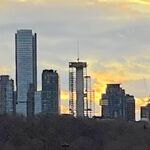Even if I'd dispute those figures and your projections, I'd still have to agree with your point. What I find ironic is people defending the TTC against a Metrolinx uploading, and they have a very valid point. Metrolinx has lost their way too. But the TTC is even worse, or at least appears to be.
Again, to keep it on-topic, this has a direct bearing on the King Project. One of my repeated points is for the Project to be granted more statutory powers, and that resides at QP. If the subway is uploaded to the Province, something being discussed in the present electioneering, then it makes sense, Toronto track gauge besides, for the King Streetcar route, being the third largest mover of passengers in Toronto, only Line 1 and 2 of the subway exceeding it, to be part of that 'upload'. It may then come to pass that all streetcar routes should be uploaded, since the routes are so interlined as to make division highly problematic.
What could this achieve, at least for King? Much greater infusion of badly needed funds for a start, and much greater power in terms of being brought under the Metrolinx Act, and a far more direct sensitivity at QP for granting standing under the Pilot section of the HTA, and eventual permanent features unique to it, but able to be adopted by other Ontario cities. (Note: K/W's Ion appears to have had this granted, still can't find their enabling legislation)
Even though I'm a bitter cynic on the TTC and Council, at the end of the day, the City is out of its depth on a lot of transit projects through no fault of its own. Like it or not, even if purely through the Constitutional structure, QP is in a far more powerful position to make the King Pilot succeed. I may have to qualify or backtrack that claim later, but I just can't see how the City is going to make this work on the present course.
Whenever I look at successful transit malls the King Pilot is attempting to emulate, none of them are run at council level. Melbourne's, for instance, is well funded and catered to by research from the state level. Ditto San Diego, from the regional level with state and federal part funding.
https://en.wikipedia.org/wiki/Public_Transport_Victoria
Melbourne's having some growing pains of late: (Most read article at today's UK Guardian)
The struggle for Melbourne Has the world's 'most liveable' city lost its way?
But they're *way ahead* of Toronto in terms of transit malls, and public transit altogether. Lessons to be learned for King Street.





